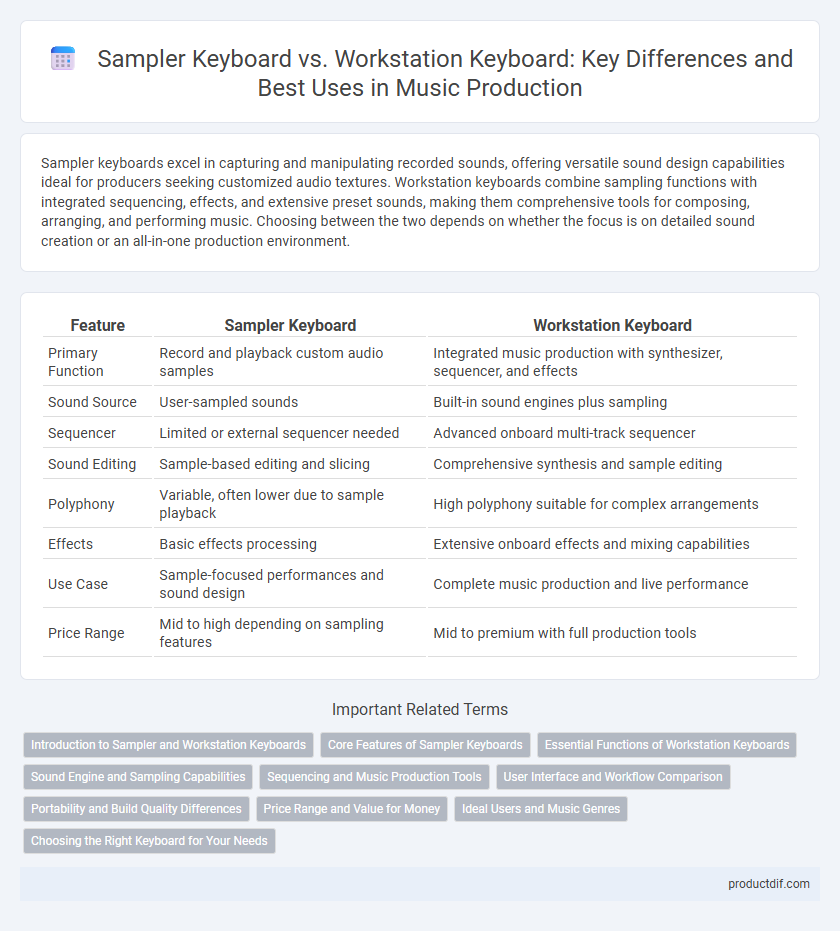Sampler keyboards excel in capturing and manipulating recorded sounds, offering versatile sound design capabilities ideal for producers seeking customized audio textures. Workstation keyboards combine sampling functions with integrated sequencing, effects, and extensive preset sounds, making them comprehensive tools for composing, arranging, and performing music. Choosing between the two depends on whether the focus is on detailed sound creation or an all-in-one production environment.
Table of Comparison
| Feature | Sampler Keyboard | Workstation Keyboard |
|---|---|---|
| Primary Function | Record and playback custom audio samples | Integrated music production with synthesizer, sequencer, and effects |
| Sound Source | User-sampled sounds | Built-in sound engines plus sampling |
| Sequencer | Limited or external sequencer needed | Advanced onboard multi-track sequencer |
| Sound Editing | Sample-based editing and slicing | Comprehensive synthesis and sample editing |
| Polyphony | Variable, often lower due to sample playback | High polyphony suitable for complex arrangements |
| Effects | Basic effects processing | Extensive onboard effects and mixing capabilities |
| Use Case | Sample-focused performances and sound design | Complete music production and live performance |
| Price Range | Mid to high depending on sampling features | Mid to premium with full production tools |
Introduction to Sampler and Workstation Keyboards
Sampler keyboards are electronic instruments that capture and manipulate audio samples, allowing musicians to play back recorded sounds with customizable effects and sequencing options. Workstation keyboards combine a wide range of sound modules, synthesizers, and digital audio workstations, providing comprehensive tools for composition, arrangement, and live performance. Both instruments enhance creative possibilities but differ in focus: samplers emphasize sound manipulation, while workstations offer integrated production capabilities.
Core Features of Sampler Keyboards
Sampler keyboards offer core features such as real-time audio recording, extensive sound manipulation, and the ability to trigger custom samples with velocity sensitivity. They provide high-quality onboard effects and multi-layered sample playback, enabling musicians to design unique sounds and textures. These keyboards typically include intuitive interfaces for editing waveforms, looping, and mapping samples across the keys.
Essential Functions of Workstation Keyboards
Workstation keyboards integrate essential functions such as multi-track sequencing, advanced sound synthesis, and real-time effects processing, enabling musicians to compose, arrange, and produce complete songs within a single device. Unlike sampler keyboards that primarily focus on capturing and playing back audio samples, workstations offer extensive built-in libraries of sounds, customizable patches, and robust control over modulation and layering. These features streamline workflow for live performance and studio production, making workstation keyboards a versatile hub for music creation.
Sound Engine and Sampling Capabilities
Sampler keyboards feature dedicated sound engines optimized for high-quality playback and manipulation of user-recorded or imported samples, allowing precise control over sample editing and layering. Workstation keyboards integrate versatile sound engines combining synthesis and extensive sampling capabilities with sequencing and arranging tools, supporting complex sound design and music production workflows. The sampler excels in authentic sample reproduction, while the workstation offers broader sonic versatility and comprehensive production features.
Sequencing and Music Production Tools
Sampler keyboards offer advanced sampling capabilities with customizable sounds and limited sequencing functions, making them ideal for sound design and triggering audio clips. Workstation keyboards excel in comprehensive sequencing features, integrated DAWs, and extensive music production tools such as drum machines, arpeggiators, and multi-track arrangers, facilitating complete song creation within a single device. Producers seeking robust composition and arrangement options typically prefer workstations for their all-in-one production environment.
User Interface and Workflow Comparison
Sampler keyboards feature streamlined user interfaces designed for quick sample editing and triggering, prioritizing real-time manipulation and simplicity. Workstation keyboards offer more complex, multi-layered interfaces with extensive menus and integrated sequencers, facilitating advanced sound design and comprehensive music production workflows. Users seeking straightforward sample playback benefit from sampler keyboards, while those requiring in-depth composition tools prefer workstation keyboards for their enhanced workflow capabilities.
Portability and Build Quality Differences
Sampler keyboards are generally more compact and lightweight, designed for portability and ease of transport, making them ideal for live performances and mobile music production. Workstation keyboards tend to have a more robust build quality with integrated features like built-in sequencers and extensive sound libraries, resulting in a heavier, less portable form factor. The durable construction of workstation keyboards supports intensive studio use but sacrifices convenient mobility compared to the typically slimmer sampler models.
Price Range and Value for Money
Sampler keyboards typically range from $500 to $2,000, offering focused capabilities for sound manipulation and sample playback ideal for producers prioritizing sonic creativity over all-in-one functionality. Workstation keyboards, priced between $1,000 and $5,000, combine sampling, sequencing, and extensive sound libraries, providing exceptional value for money to musicians seeking an integrated production environment. Choosing between them depends on budget constraints and the desired balance between specialized sampling features and comprehensive music production tools.
Ideal Users and Music Genres
Sampler keyboards suit electronic music producers and hip-hop artists who require precise control over custom sounds and loop manipulation. Workstation keyboards benefit composers and live performers in genres like pop, rock, and film scoring, offering integrated sequencing, diverse sound libraries, and real-time arrangement tools. Selecting between the two depends on whether users prioritize sample editing and sound design or comprehensive composition and performance capabilities.
Choosing the Right Keyboard for Your Needs
Sampling keyboards excel in capturing and manipulating audio clips, ideal for producers focused on sound design and beat-making, while workstation keyboards integrate comprehensive sequencing, arranging, and sound synthesis tools suitable for composers and live performers seeking an all-in-one solution. Prioritize the sampler keyboard if your workflow emphasizes sound customization and loop-based production, whereas a workstation keyboard benefits those needing versatile music production capabilities and extensive preset libraries. Assess your requirements for portability, interface complexity, and available connectivity to select the instrument that best complements your creative process.
Sampler Keyboard vs Workstation Keyboard Infographic

 productdif.com
productdif.com